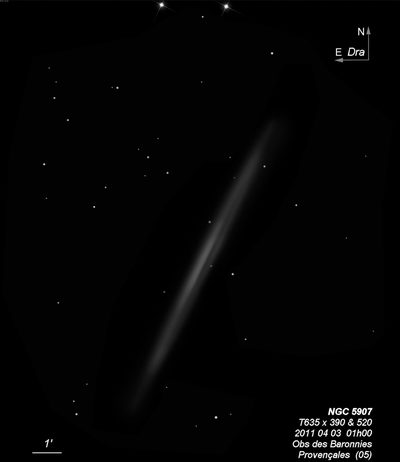
William Herschel discovered NGC 5907 = H II-759 = h1917 on 5 May 1788 (sweep 842) and recorded "pB; 8 or 10' long, 1.5' or 2' broad, FNM." On sweep 347, JH logged "B; a superb ray nebula, at least 7.5' long and narrow, pos = 159.9° by meas; at first vgb, then psmbM."
George Stoney was the first to note the dust lane on 13 Apr 1850 at Birr Castle. He described a "very remarkable ray, 12' or 15' long; alpha, beta, gamma and delta are stars, of which alpha is faint; a longitudinal split precedes the nucleus." A faint star was sketched within the portion to the west of the dust lane. The dust lane was confirmed on 13 Apr 1855. On 23 Apr 1860, Samuel Hunter described "south-preceding nucleus there is a dark space with vF neby beyond, & south-following nucleus is rather dark with a portion much brighter beyond, then another dark space and again neby." The faint portion of the galaxy preceding the dust lane was catalogued as GC 4086 = NGC 5906.
200/250mm - 8" (6/5/81): impressive, needle-like streak.
300/350mm - 13" (6/18/85): very large, very elongated, narrow streak, bright core, faint star is west of the core.
400/500mm - 17.5" (6/6/86): fairly bright, extremely large edge-on 9:1 NNW-SSE, extends to roughly 13'x1.5'. Contains a bright core increasing to a near stellar nucleus. A mag 14 star lies 1.1' W of center.
600/800mm - 24" (7/8/13): this showpiece edge-on contains a very bright, large, thin extended core but no well defined nucleus. The galaxy nearly fills the 15' field at 280x, extending ~12'x1', with a patchy surface brightness towards the tips. A thin dust lane on the preceding side of the core can be traced at least 5'. A thin, low surface brightness strip (catalogued as NGC 5906) is visible on the west side of the dust lane.
900/1200mm - 48" (4/21/17): at 375x; huge showpiece splinter extending 10' to 12' NW-SE and ~0.8' wide. The central 2' long core region is very bright and contains a slightly brighter nucleus. The outer extensions have a lower, irregular surface brightness and appear patchy. A sharply defined dust lane slices through the central region, creating two asymmetric sections with the thin, brighter core section on the eastern side. An easily visible glow is on the western side of the dust lane (catalogued separatedly as NGC 5906), though it has a much lower surface brightness. A mag 14 star is 1' W of the core. Overall, the view was very comparable to the DSS2 image.
Notes by Steve Gottlieb